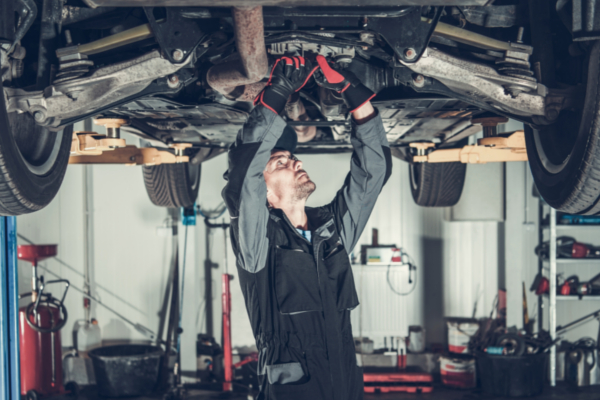
How the Drivetrain Works
When a car is started, the engine creates enough energy to power the flywheel. In conjunction with the transmission system, the flywheel distributes power to other parts of the drivetrain. Another component called the driveshaft spins to power the differential, which uses the drivetrain’s full momentum to move the wheels.
Visually, the drivetrain consists of a steel tube connecting the transmission and wheels. The tube helps move mechanical power from the transmission to other parts of the vehicle. In the process, the U-joint helps with transmitting that power to the driveshaft, which houses the constant-velocity (CV) joints needed to keep the wheels moving at the same rate.
The axle shafts, located on both sides of the differential, further help transmit that power from the drivetrain to the wheels. By contrast, the powertrain includes the complete drivetrain, engine and everything else needed to change kinetic energy into momentum to propel the vehicle forward.
Issues with the Drivetrain
When the typical process does not occur smoothly, your vehicle may rattle or shake while moving. Unfortunately, the drivetrain can suffer the same issues that all systems and parts within your car do: Parts wear out and need to be replaced.
As one of the more significant aspects, lubrication with oil or fluid reduces the amount of wear exerted on the gears and bearings. To keep the system functioning up to par, the CV-joints, axles, U-joint and driveshaft should be greased whenever you get an oil change. Similarly, don’t forget about the differential – these parts also require oil or will eventually be worn down.
Lubrication aside, rubber in the CV joint may eventually start to crack. When this occurs, the oil or grease in the joint can seep out when the axle moves. With time, the joint begins to make a clicking noise and won’t transfer power as efficiently, which may cause axle failure.
Stemming from these issues, your car’s drivetrain should be examined if:
- You notice a clunking sound during shifts or while the vehicle is moving.
- The vehicle shakes while you drive.
- You notice vibrations when you move, especially when you start to accelerate. The vibrations may be concentrated toward the floorboards or whenever you shift gears.
- You feel resistance whenever you turn around a corner.
- The car seems to make high-pitched noises or squeaks.
- You hear a rumbling or grinding sound.
- The transmission fluid is leaking, has a strong smell or looks muddy.
- Your tires have started to experience uneven wear.
Repairs to the Drivetrain
Due to cost effectiveness, not every part in the drivetrain can be repaired. Rather, the axle’s boots and joints often get replaced when they start to show wear.
Aside from having new parts installed, maintenance may include:
- CV Joints: As these flexible parts see a significant amount of motion and assist with transferring power to the differential, their cage, bearings and CV boots may need to be replaced.
- Differential Maintenance: Without sufficient lubrication, parts in the differential will start to wear down, generate heat and weaken, which can lead to premature failure.
- Driveshaft: When sufficient power is no longer being sent to the wheels, other areas need to compensate. To avoid other parts needing repairs, the driveshaft may need to be replaced.
If you’ve noticed any of these signs, schedule a diagnostic appointment for your drivetrain. Our technicians will assess your vehicle’s parts and systems to recommend any necessary repairs.

